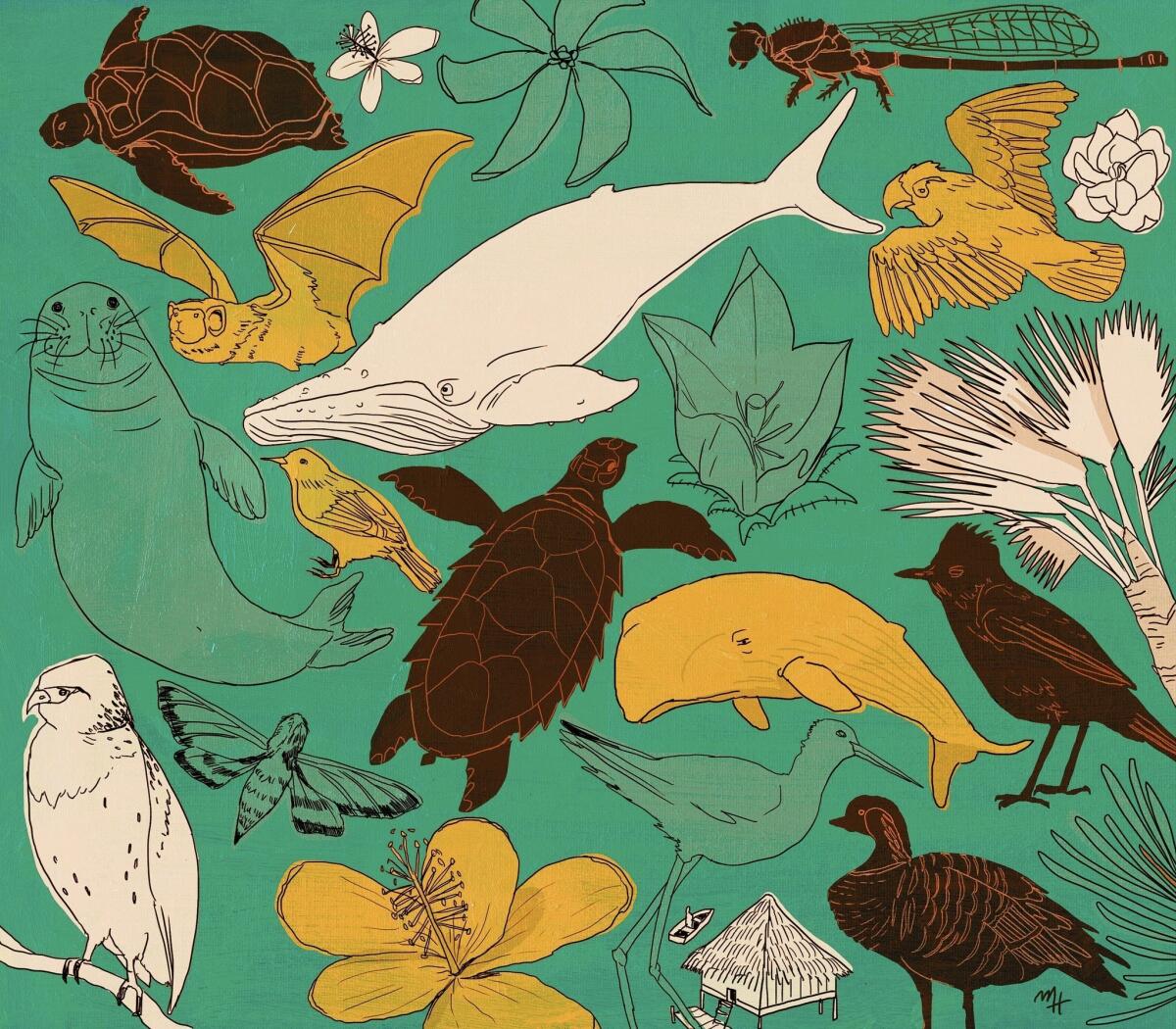Op-Ed: Paradise losing: Many Hawaii species are on the road to extinction

- Share via
Each year I await with dread the federal government’s catalog of endangered and threatened species in the Hawaiian Islands, where I was raised and where I live.
On its 2015 list, the Fish and Wildlife Service included the ‘ea, or hawksbill turtle, as well as the green turtle, Ridley sea turtle, leatherback turtle and loggerhead turtle. Four mammals are considered endangered: the Hawaiian hoary bat; the kohola, or humpback whale; the sperm whale; and the endemic Hawaiian monk seal. Among the 34 endangered birds are the Hawaiian goose, or nene; the Maui parrotbill; the Nihoa millerbird; the red-legged stilt; and the i’o, or Hawaiian hawk. There were once 99 species of tree snails in the Islands; of the 25 that survive, nine are endangered. Fifteen anthropods are at risk, including the sphinx moth and the oceanic damselfly.
Among the endangered plants are a white hibiscus found only in Wailau Valley on Molokai; the lovely Hawaiian gardenia or na’u (although now widely cultivated in an effort to save it, there are only two or three plants remaining in the wild), the mountain silversword of Mauna Loa; the lo’ulu, or Pritchardia palm; and one small yellow campanula (Brighamia insignis) last seen on a cliff on Kauai.
It is simply unforgivable that such adaptive and resilient species as those indigenous (native, but occurring elsewhere) and endemic (occurring nowhere else in the world) to the Hawaiian Islands should so easily be allowed to vanish from the planet.
The chance of any species reaching and then surviving on an island as distant as one of the Hawaiian chain is infinitesimal, but despite the extraordinary odds, plants and seeds found their way ashore, carried by the tide or blown by trade winds, inside birds or in their feathers, in the branches of trees and in the jetsam of sunken ships.
Such an event is thought to have occurred only 300 times in the history of Hawaii, meaning that on average, if one takes 70 million years as the life of the islands, one seed or sapling was successfully introduced every 20,000 to 30,000 years. Many of those species have now disappeared.
According to the Bernice P. Bishop Museum, 271 species of all indigenous and endemic flora and fauna (introduced by various means) have become extinct in the last 200 years alone.
Although the decimation of species is due to commercialization, the loss of forests, hunting, the growth of population, pervasive alien introductions and most recently global warming, it began with the first voyagers from Polynesia in the 7th century, who brought to the islands their own plants and animals, including pigs, chickens and dogs, which ensured the survival of the settlers but threatened those native species that were innocent of predators.
In the early 19th century, rapacious Hawaiian chiefs were responsible for the disappearance of vast sandalwood forests, the fragrant wood sought by the Chinese for incense, and for the loss of thousands of native birds killed to make the yellow, red and green feather capes, leis and helmets of the nobility.
Hawaii’s first king, Kamehameha I, must be held accountable for some of the early loss of plants, thanks to the taboo he issued on the cattle given to him in 1793 by Capt. George Vancouver. The cattle, and later goats, were allowed to roam wild in the uplands, where they destroyed the delicate ferns, vines, trees and grasses that had provided generations of Hawaiians with food, fishing lines, nets, vegetable dyes, timber, medicine, barkcloth and thatch for their houses.
European contact, which began in 1778 with the discovery of the islands by Capt. James Cook, brought disease and the further destruction of ecosystems. In the 19th century, the spread of large sugar plantations ensured that additional acres of native grasslands and forests, and the creatures that lived in them — many of them natural pollinators — were heedlessly destroyed. Large cattle ranches, particularly on the Big Island, meant that the forests and valleys that were once home to numerous species were turned into grazing land.
Despite its rank as the state with the highest number of endangered or threatened species, Hawaii receives less than 5% of the funding allotted by the federal government’s endangered species program — $1.5 million in 2013 out of $32 million given to 20 states, a third of which went to buy 635 acres of forested land on Oahu, while the rest was given to Kauai to plan habitats for birds.
Private landowners, community watch groups, conservation groups, local government agencies and even schoolchildren are increasingly aware of the great loss that is underway, but for many species, it will be too late.
Friends of mine despair that there is not enough compassion, not enough will, not enough time or money to go around. Is the disappearance of the Hawaiian cave wolf spider, they ask, or the Hibiscadelphus distans, one of the world’s rarest trees, that important to most people? Especially in comparison to human lives? People will be able to survive, of course, without honeycreepers and monk seals. But if the wolf spider is in trouble, we are in trouble too.
Susanna Moore is the author, most recently, of “Paradise of the Pacific: Approaching Hawaii.”
Follow the Opinion section on Twitter @latimesopinion and Facebook
More to Read
A cure for the common opinion
Get thought-provoking perspectives with our weekly newsletter.
You may occasionally receive promotional content from the Los Angeles Times.






